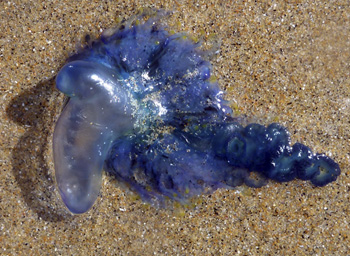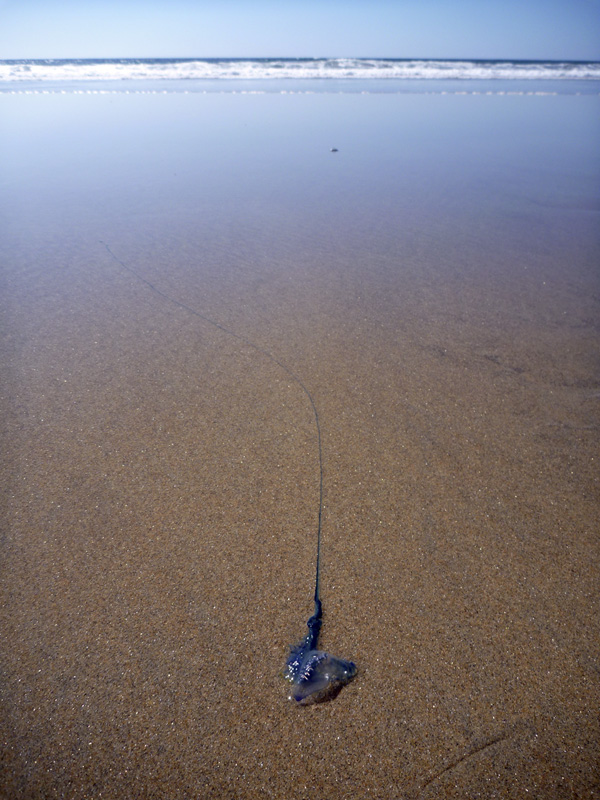Published in the Ocean Watch column, Honolulu Star-Advertiser © Susan Scott
March 11, 2013
My walk down the length of Kailua Beach on a recent blustery day brought back memories of another windy day there in 1983. Marine animals were new to me at the time and every day at the beach felt like Christmas.
“Look, I found something amazing,” I said to Craig one afternoon, showing him my treasure. Between thumb and forefinger I held a transparent bubble 2 inches long topped with a pink ruffle. A fringe encircled the bubble like a blue tutu, and below that, fluttering in the breeze, hung the creature’s tail.
 A Portuguese man-of-war blown onto a beach.
A Portuguese man-of-war blown onto a beach.
©2013 Susan Scott
Craig, a seasoned ocean-goer, laughed.
“It’s called a Portuguese man-of-war, and that’s no tail. It’s a stinging tentacle. It’s probably not a good idea to carry it around.”
I didn’t carry it for long. I put it in a bucket of seawater. Afloat, the creature came alive, slowly extending its tentacle into the water as if sighing with relief.
I couldn’t wait to get home and learn more about this strange creature with the odd name, and I’ve been learning about them ever since.
Fortunately for me, the balloon part of the stinging Portuguese man-of-war, a jellyfish relative, is safe to touch. It’s this smooth transparent sac, containing mostly carbon monoxide, that enables the animal to float on the ocean’s surface.
Along the length of the float lies a blue or pink crest. During periods of calm weather, the crest flattens and the animal drifts with the current. But when the wind blows, the creature sets sail, raising its crest to cruise at a 45-degree angle to the wind. In this way, the Portuguese man-of-war, named after 16th-century battleships, trawls for fish.
Stinging cells line the tentacles (some individuals have more than one) that trail beneath the animal’s float. Acting like tiny harpoons, the cells shoot a paralyzing toxin into the prey. Once a fish is immobilized, the tentacles draw it up to the creature’s mouth, also located under the float.
Normally, Portuguese man-of-wars float offshore throughout the world’s tropical and subtropical waters. We see them, and sometimes feel the pain of their stings, when the wind overpowers their tiny sails and the animals get blown into our bays and onto our beaches.
As a fellow sailor, I feel a tinge of sadness when I find these little anglers lying on a beach. The last thing in the world Portuguese man-of-wars want is to be blown off course and shipwrecked.
Craig was right about handling them, though. It’s not a good idea, because even when these creatures are beached, their tentacles retain the ability to sting.
I don’t carry Portuguese man-of-wars around anymore (usually). But I still see them as amazing gifts from the sea.
